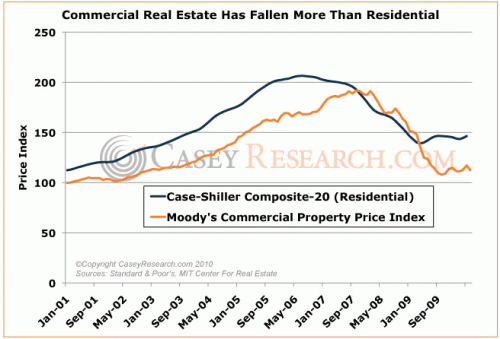Delay and Pray, and Then?
By Jake Weber
While it may be hard to believe, the housing market hasn’t been the worst-performing real estate sector in terms of price. The index for the Case-Shiller Composite-20 index for residential real estate peaked in July 2006, and as of May 2010, the index had dropped by 29.1%.
Considering how dismal the recent housing data has been, we can certainly expect for the Case-Shiller index to continue its downward trajectory. However, it still has some catching up to do with its counterpart that tracks national commercial real estate prices. The Moody’s Commercial Property Price Index peaked in October of 2007, and as of June it had already lost 41.4% of its value.
Making the situation potentially much worse, the price declines in commercial properties have occurred absent a major wave of default in the commercial sector – at least one comparable to what we saw in housing. Rather than accept losses, lenders have been carrying commercial loans on their books at pre-crash values, pushing the problem down the road in a strategy dubbed “delay and pray.”
Rearranging the deck chairs on the Titanic has worked for many lenders so far, but as this article from Crain’s Chicago Business demonstrates, procrastination can’t prevent the inevitable:
A Georgia firm that holds two junior mortgages on the 46-story tower at 500 W. Monroe St. says the building’s loans went unpaid when they came due this month and that the company may foreclose and take control of the property.
It would be the first foreclosure of a major office tower in the Loop in 11 years and a sign that the market remains mired in the hangover of the debt-stoked valuation bubble that peaked in mid-2007. That’s when Broadway Partners Fund Manager LLC, a once high-flying New York firm, bought 500 W. Monroe for $336.7 million, with a package of loans that made up more than 95% of the purchase price.
Mr. Fasulo reckons that 500 W. Monroe could be worth about $240 million today, based on an estimate of the building’s net operating income and the return investors would expect since the tower is just 70% leased. That would put its current value at roughly 30% below the 2007 purchase price, a decline in line with national trends. A report last week by New York-based Moody’s Investors Service showed property values in the top 10 U.S. office markets have plummeted 31% since the 2007 peak.
The building’s current value is also $84 million less than the $324 million Broadway borrowed to buy it. The sunken value, debt load and uncertainty about 500 W. Monroe’s future ownership weigh on leasing efforts, sources say.
Piedmont, which bought a slice of the tower’s debt in March 2008, said in a Securities and Exchange Commission filing that the borrower missed an Aug. 9 maturity date and that Piedmont exercised its right to extend the maturities of two senior loans, including a $140-million mortgage held by commercial mortgage-backed securities investors.
The filing says Piedmont is “considering its options for enforcement of its collateral, one of which is a potential foreclosure.”
Lenders have delayed and prayed, but as prices continue to decline, borrowers are finding it much easier just to walk away, or to send “jingle mail,” as this article from the Wall Street Journal put it:
Companies such as Macerich Co., Vornado Realty Trust and Simon Property Group Inc. have recently stopped making mortgage payments to put pressure on lenders to restructure debts. In many cases they have walked away, sending keys to properties whose values had fallen far below the mortgage amounts, a process known as "jingle mail." These companies all have piles of cash to make the payments. They are simply opting to default because they believe it makes good business sense…
More landlords are expected to follow suit. Of the $1.4 trillion of commercial-real-estate debt coming due by the end of 2014, roughly 52% is attached to properties that are underwater, according to debt-analysis company Trepp LLC. And as the economic recovery sputters, owners of struggling properties are realizing a big property-value rebound isn’t imminent.
Owners of commercial property have an easier time walking away than homeowners because commercial mortgages are typically nonrecourse. That means the biggest penalty for walking away is the forfeiture of assets and cash flow they may generate.
The obvious conclusions are that we can expect rents and lease rates to decline further, more defaults and foreclosed properties in the commercial real estate sector. Taking it a step further, this will probably lead to many more bank failures, as much of the commercial mortgages and CMBS are concentrated in the local and regional banks.

Comments are closed.